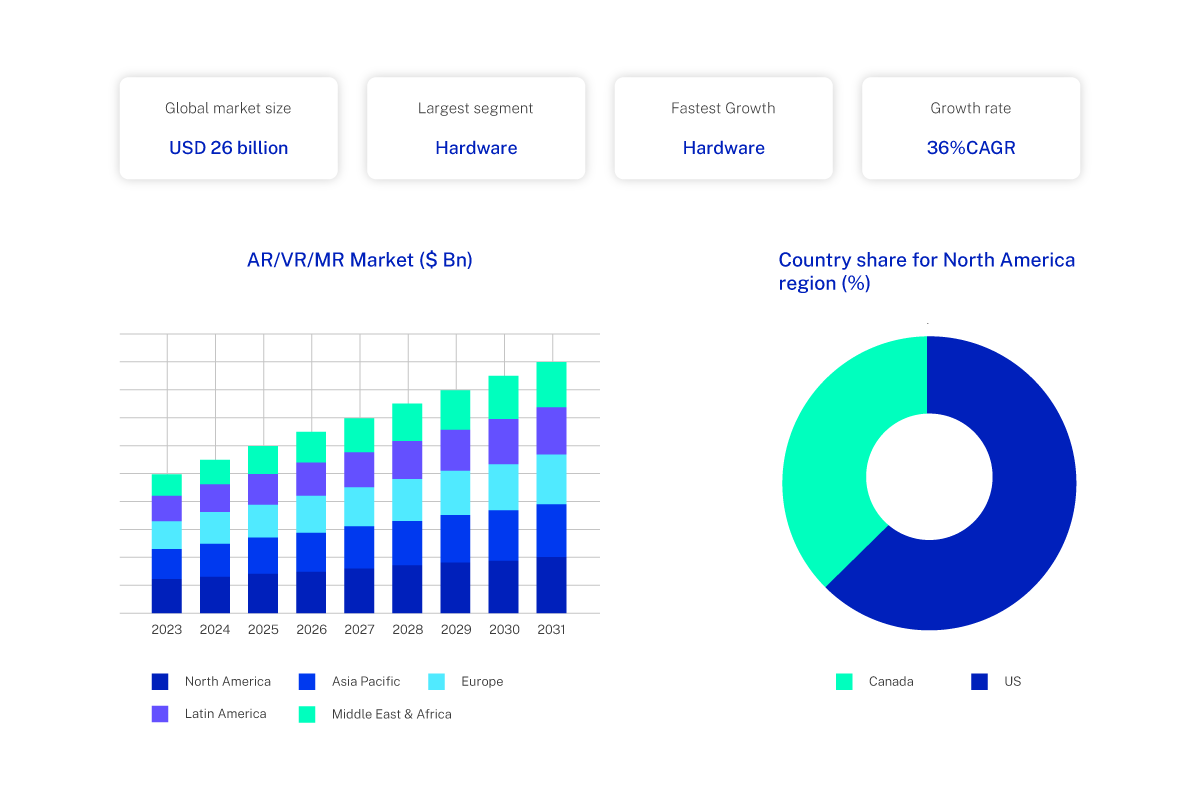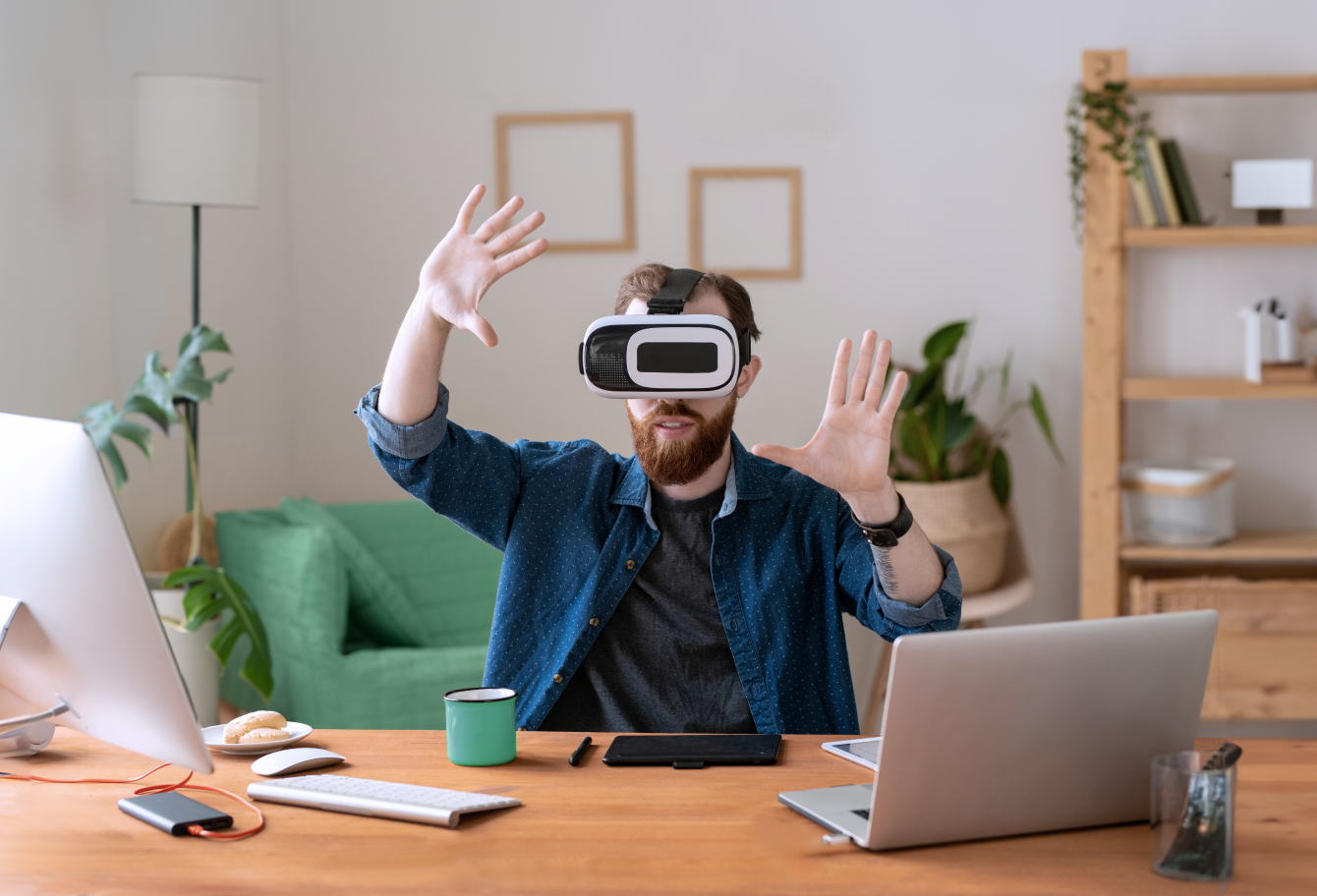Key Takeaways
- Augmented Reality technology has become more mainstream in recent years
- Industry-specific technologies are gaining ground
- Health, accessibility and ethics are all key challenges
- Businesses exploring AR and VR now will succeed long-term
Current State of AR/VR Market
Augmented reality (AR) and virtual reality (VR) have gradually found more practical use cases in recent years - but the use of the technology is set to expand exponentially in the years to come. According to Skyquest, the global market value of AR and VR stood at around $30 billion in 2022 - but by 2031, this is expected to rise to more than $520 billion.
Driving this growth are the rising number of practical use cases that are emerging for the technology all the time. These range from immersive learning and social VR platforms, through text detection and translation, to greater integration between AR, VR and artificial intelligence, and much more. In this blog, we’ll explore AR and VR trends for 2025 and beyond, and AR/VR future predictions around how the industry will progress.

Major VR and AR Trends for 2025 and Beyond
Augmented and virtual reality technology dates back to the 1960s, but in the last decade or so, AR and VR have moved from innovative new trends to practical real-world technologies. The likes of Google Glass AR glasses (2014), the Pokemon Go AR-driven game (2016) add Microsoft HoloLens as well and the Apple Vision Pro mixed reality headset (2024) have put AR and VR technology into the hands of the general public.
So now that the everyday use of AR and VR is being normalized, what does this mean for the next steps of its development? We see major gains being made in five key areas:
 Integration of AI in AR/VR
Integration of AI in AR/VR
Advances in AI have driven major enhancements to AR and VR technology, improving rendering, tracking and processing. This has made an especially big difference in gaming, in the realism of 3D characters and environments, and the dynamic possibilities of game scenarios and interactivity.
The realistic simulations that AI can support can also help medical students practice procedures, enable engaging learning experiences for students, and create immersive user experiences for consumers.
 Rise of AR Avatars and Virtual Beings
Rise of AR Avatars and Virtual Beings
The digital avatar market in the U.S. accounted for over 82% revenue share in 2023, and now AR avatars are increasingly bringing the physical and digital worlds together. AR glasses and smartphone cameras bring interactive digital elements to the real world; they can help social media users identify and interact with other users on their chosen platform, while more and more retailers will use them as virtual assistants that can provide tailored support and personalized offers and recommendations.
 5G and Its Impact on AR/VR
5G and Its Impact on AR/VR
5G services have the potential to take AR and VR to the next level, especially as they can enable split rendering that maximizes throughput and minimizes latency. For example, the speed of experience that 5G can enable could support real-time customer service and support, product demonstrations, teaching during live medical procedures, in-person instruction, and collaboration on design and architecture projects.
 WebAR and Cross-Platform Applications
WebAR and Cross-Platform Applications
WebAR allows users to access advanced AR experiences through their browsers, rather than having to install specific applications onto their device. This is a major step forward in making AR and VR accessible for a greater range of users. It will make the technologies more compatible across all platforms and operating systems, and support smoother and more consistent user experience.
 Wearable AR/VR Devices
Wearable AR/VR Devices
AR and VR technology is being integrated into more and more wearable devices all the time, with smart glasses and headsets becoming more commonplace. This area of development is still in its infancy, and consumer complaints around discomfort with the Apple Vision Pro post-release shows that there is plenty of scope for further VR innovations and improvements in the years to come.
Augmented Reality Predictions and Virtual Reality Forecasts By Industry
As the use cases of AR and VR expand, so there will be greater innovation focused on specific industries, especially in the following:
 Education and Training
Education and Training
AR and VR have huge potential in making learning more immersive, engaging and interactive. This can be through overlaying information into real-world environments, supporting remote and virtual collaboration and easy information sharing, and by enabling personalized learning environments and experiences.
 Retail and E-Commerce
Retail and E-Commerce
In the world of retail, AR and VR can give customers all the benefits of physical shopping when they browse and buy online. Virtual try-on technology allows customers to see how clothes will fit their bodies before committing to a purchase, reducing the risk of dissatisfaction or time-consuming returns. Building this level of experience engineering into buying journeys can transform customer engagement.
 Healthcare and Medical Training
Healthcare and Medical Training
AR and VR can be deployed in a host of healthcare-related scenarios, such as enabling surgery simulation that trains medical students in situations that closely resemble what they’ll face in the real world. Through experience engineering, they can also support more advanced diagnosis procedures through data visualization, support remote consultations for patients and offer treatments for conditions lacking traditional medical solutions, such as phobia therapies.
 Manufacturing and Engineering
Manufacturing and Engineering
VR solutions make it possible to visualize how a product will look in real life before a prototype is even created, so that ideas can be refined and perfected before time and investment is committed to manufacturing. Not only does this improve the precision and efficiency of the development process, but the same principles allow further gains to be found in staff training and ongoing maintenance.
 Entertainment and Gaming
Entertainment and Gaming
In order to reach players in an increasingly competitive gaming industry, it’s vital to offer players immersive and personalized experiences, built through experience engineering. AR and VR can support games that are more engaging and attuned to the preferences of the individual customer, maximizing their satisfaction and boosting revenue in the process.
Challenges and Considerations around Emerging AR Technologies
For AR and VR to become the global mainstream success that it could be, there are some challenges to address along the way. Accessibility and inclusivity is one of them, although the growth of WebAR is going some way to addressing that in making AR and VR use more platform-agnostic.
On a more physical level, the prolonged use of AR and VR technologies can cause some health issues, such as dry eyes and headaches caused by some head-mounted displays. Safety improvements in this area are essential, and should be addressed alongside other shortcomings like the expense of devices, mass production requirements and limitations in battery life and field of view.
Additionally, as awareness of AR and VR technologies increases, there will be ethical considerations to account for. More people are wary of data misuse, cybercrime, privacy and invasive advertising, so companies behind AR and VR development will need to be careful and transparent about how users and their data will be protected.
In Summary: Preparing for the Future of AR/VR
It’s likely that by the end of this decade, AR and VR will be part of everyday life for most of us, and that people will be interacting digitally in 3D rather than in 2D. So it’s the organizations that start leveraging these AR and VR trends now that will be setting the pace, and will be best-placed to stand out as market leaders in the years to come.
One of the keys to AR and VR in the long-term is accessibility: ensuring that as many people as possible are able and willing to use the technology. And that starts with experience engineering, ensuring that new developments are focused on what the end-users will get out of AR and VR. The businesses that meet these user demands will find themselves with the most popular solutions in the long-term.
Ready to leverage AR and VR trends for your business? Contact Ciklum's experts today to explore how we can help you stay ahead in the rapidly evolving world of immersive technologies. Let's shape the future together!
Blogs



































